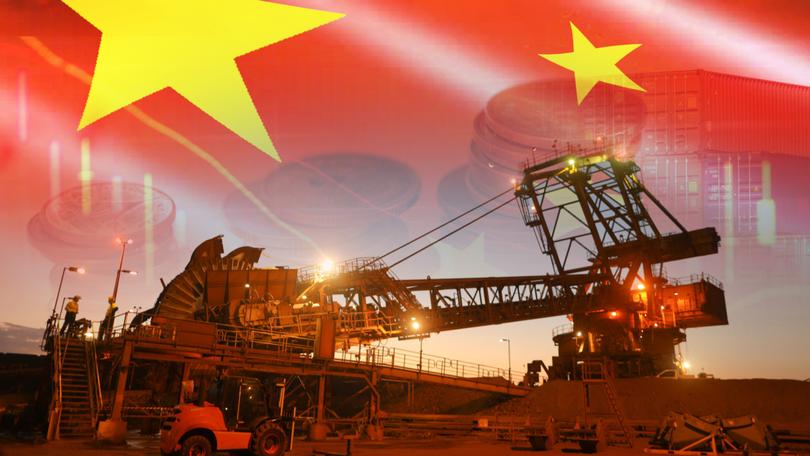China’s unlikely to be saviour for Australia as dollar falls and mining stocks sold off

Two strong warning signals sent by markets have kicked off 2025.
Both relate to China.
While many traders are still on holidays, swings are amplified but the sell-off in mining stocks suggest that investors are worried that China’s stimulus is not going Australia’s way.
Sign up to The Nightly's newsletters.
Get the first look at the digital newspaper, curated daily stories and breaking headlines delivered to your inbox.
By continuing you agree to our Terms and Privacy Policy.The big iron ore names, BHP, Rio and Fortescue, all fell more than 1.5 per cent following a two-day losing streak for the iron ore futures.
The sell-off follows Chinese manufacturing data released on Friday that showed while the sector is still expanding, the pace of growth is slowing.
The Caixin purchasing manufacturers index showed a barely positive reading of 50.5 in December (above 50 is expansionary) down from 51.5 in November after manufacturers received a bump thanks to government stimulus programs announced in late September.
The other big warning sign has been the drop in the Australian dollar. From a high of US70 cents on news of that China stimulus, the Aussie has plunged back down toward 60c.
China’s currency has also been falling since the stimulus announcement.
The fall in the yuan is driven by a sharp decline on the returns offered by Chinese bonds.
They have dropped to such a low level – 1.9 per cent for 30-year Chinese government bonds - that they are now weaker than the poster child of stagnation, Japan.
Stimulus sugar hit masks serious issues
The post-stimulus bump looks like a false dawn.
While retail sales bounced in October, up a to a yearly high growth rate of 4.8 per cent, the sales uplift was driven by a longer-than-normal online promotion season (much like the extension of Australia’s Black Friday sales) and by the Chinese government offering subsidies for online purchase.
The manufacturing boost also feels like China trying to squeeze the last remaining drops from the lemon.
Aware that Trump’s tariffs could be imminent, Chinese manufacturers have been exporting at a massive clip, with the annual trade surplus on track closing in on $US 1 trillion.
Research from ANZ suggests that China has been front-loading exports in anticipation of tariffs, with the “higher trade surplus with the US and EU particularly concerning under the intensified global trade tension”.
Despite the upswing, which includes expansionary conditions in the services sector, reported today, employment is challenged, with manufacturers and services businesses alike contracting in terms of hiring.
Concerns about forward orders from international customers drove the decline in optimism, the surveys said.
That puts the Chinese government in a serious bind. It will have to rectify domestic economic issues, while likely losing one of the most critical components of its 20 year economic growth story – exports.
The challenge in bringing growth back
China’s prosperity was built on its incredible manufacturing ecosystem, which required massive infrastructure investment, a wave of migration from the regions to the cities, and a program of encouraging real estate investment backed by local government.
Real estate investing made sense, with house prices rising tenfold since the early 90s, according to a research paper from former International Monetary Fund economist Kenneth Rogoff.
With restrictions on what else citizens could invest in, property became the number one investment, pushing Chinese household debt up three-fold from 2008 to 2023 as property buyers from 20 per cent to 60 per cent of GDP.
Construction boomed to account for 25 per cent of China’s economy, Rogoff found, leading to massive over-investment, that has created an excess of 80 million housing units.
The oversupply has torched Chinese savings, with prices falls particularly dramatic in tier three cities, which account for 60 per cent of GDP.
The Wall Street Journal quotes Barclays research that estimated the cumulative losses for Chinese property owners is $US18 trillion, equating to $US60,00 per household.
Those property losses are larger than the wealth destruction caused in the global financial crisis for the entire US property and stock markets.
It is equivalent to a full year’s GDP, the WSJ said.
While asset prices are falling, relative debt is rising, with the debt service ratio for households and non-financial companies now higher than US households at the peak of the GFC.
While consumers poured debt into housing, the government, including state and local governments, poured debt into propping up the manufacturing sector, which is why China now accounts for 30 per cent of global production.
With constrained consumers, that excess output has caused prices to plummet, as has been particularly seen with green technologies such as electric vehicles, batteries, and solar panels. Lacking customers at home, those cheap goods have flooded export markets.
But the very export competitiveness that China has been using to get out of its slump has backfired, with tariffs from the US and from Europe likely to squeeze manufacturers further.
So having driven its economy on a debt binge that has pushed household, government and local debt to 300 per cent of GDP, China must do more to try keep growth at its stated target of five per cent.
ANZ estimates that China will have to further expand the national balance sheet, along with cutting interest rates further. Even then, ANZ expects that deflation is a core threat, and youth unemployment which is already at 17 per cent will be worsened by a further 12 million university graduates entering the market.
Big bang stimulus unlikely
Australia has been a beneficiary of China’s efforts to stimulate its economy out of the doldrums. That sent the iron price soaring during COVID, propping up government coffers.
But Barry Naughton, one of the leading experts in the Chinese economy, and chair of Chinese International Affairs at UC San Diego believes that this time Xi Jingping will not be putting money into the kind of big-ticket infratstructure programs like high-speed rail that so benefited the steel industry.
Instead, his focus will be on technologies that allow China to “decouple” from the rest of the world in areas like energy security. That is why China has invested so heavily in electric vehicles, battery technologies and even in making its own computer chips.
Speaking The Wire China, Naughton said Xi has presided over a five-year stimulus program “hidden in plain sight” that has directed money to the high-tech industry.
Unfortunately, he told The Wire China, “it doesn’t create much employment, it doesn’t create much profit, it doesn’t create many new income streams, and so it doesn’t have stimulus multiplier effects.”
High-tech workers are benefiting, Naughton said, but millions of migrant workers are returning to provinces with nothing much to do. He believes Xi is more concerned with a relatively smallish cadre of urban tech workers and government employees and any reform policies will more likely assist them than those at the lower end of the income ladder.
End of an era for Australia
The solution to China’s predicament likely lies less and less on Australian inputs. In an era where government spending here is growing as the population ages, the long-term conditions appear to be fading.
Iron ore is on the front line but our universities would be worried too. Agriculture and tourism may remain beneficiaries of a wealthy upper stratosphere of Chinese society but the trajectory toward mass affluence that China had been pursuing may no longer be fulfilled.
It puts more pressure on the structural deficits that will come with baked-in spending programs and dramatically highlights the need to find alternative sources of growth.

